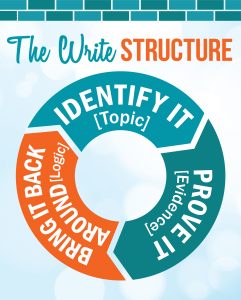Note from Dave: This article is actually by Lindsay Veitch, educator and author of The Write Structure. Enjoy!
I brought my two-year-old to his pediatrician, Dr. Lisa Brown, for a well-visit the day we launched my ebook, The Write Structure. I casually mentioned this exciting news to Dr. Brown, and she replied as only the doctor of children could.
With an incredibly warm look on her face, she asked a remarkably direct question, “That’s wonderful! Can you crystallize your text in one or two sentences?”
 Well, that’s not much to work with, doc, but here goes: “The Write Structure is a simple format that is totally transferable. The book is based on solving a common problem with writing in schools. Kids don’t know where to start, so they loathe writing. When teachers recycle The Write Structure (and the teaching methods that go with it), kids’ anxiety goes down and success goes up.”
Well, that’s not much to work with, doc, but here goes: “The Write Structure is a simple format that is totally transferable. The book is based on solving a common problem with writing in schools. Kids don’t know where to start, so they loathe writing. When teachers recycle The Write Structure (and the teaching methods that go with it), kids’ anxiety goes down and success goes up.”
Okay, so I cheated on the two sentences thing.
Dr. Brown didn't bat an eye at my rambling answer; instead, her face lit right up! She went on to explain that writing is often the primary academic struggle her adolescent patients mention.
“While they may love school, many kids express anxiety about feeling unsuccessful at writing.” She then applauded any work that teachers and administrators are doing to alleviate students’ stress about writing.
This mid-checkup conversation with my two-year-old’s pediatrician affirmed what I already believe: writing is tricky and complicated for kids.
We know many students struggle with writing. Informal polls repeatedly report writing as one of students’ least liked academic tasks, mainly because they see their writing ability as a weakness, not a strength. Kids often don’t see themselves as successful writers because writing, often and unfortunately, is a shot in the dark. Even some kids who are legitimately good writers feel that the task of writing is a struggle. Overwhelming prompts and empty text boxes disengage many kids. Students will be asked to write hundreds and hundreds of times throughout their K-12 education and endless times as adults. As teachers and educational leaders, we must find a way to ease stress about writing so students can attack prompts with confidence and success.
As a teacher, I became aware of the need for a simple, transferable writing format when, in the course of five years of teaching, the state standards and standardized test changed. Then, the district summative assessment tools changed in order to align to the new standards and state assessments. I had designed many of my materials based on those tests, only to redesign them 12 months later. Call me crazy, but I figured that chances were I’d once again be realigning sometime in the next several years unless I could think beyond the tests. From this, my method for teaching writing was born. I decided to
- Develop a basic writing format, or structure, that transcends grade levels and content areas
- Base my writing instruction on best-practice methods and strategies that are proven to show results
- Weave that basic writing format and those best practices into all subject areas I could and in as many tasks as possible all year long
Over the last five or so years, I have applied The Write Structure to all my writing instruction, including modeling, conferring, range-finding, scoring guides/rubrics in English language arts and social studies over and over throughout the entire year. The results have been astounding!
Kids use the format to write basic paragraphs on a weekly basis, it’s recycled on more in-depth essay outlines, and I’ve seen dozens of kids turn blank paper on the state test into an outline using the three part structure as their guide. The simple format is easy for kids to remember and follow (there are hand motions and a cheer to boot!) even when there isn’t an outline or rubric provided. The format is transferable to any content area, any grade level, any writing task, and any scoring guide.
Let me try again to crystallize my text in two sentences:
I took a simple, memorable format, married it with best-practice teaching strategies that work, and recycled the combination of the two over and over. As it turns out, the marriage is a win-win for kids and teachers: less stress, more confidence, and we all write happily ever after.
Want to learn more about The Write Structure: A Simple, Effective Method for Teaching Writing Across the Content Areas?
A thorough explanation of the three part writing format, best practice writing strategies, and 14 exclusive writing lessons are all in Lindsay Veitch's ebook, which is available here.
Leave a Reply